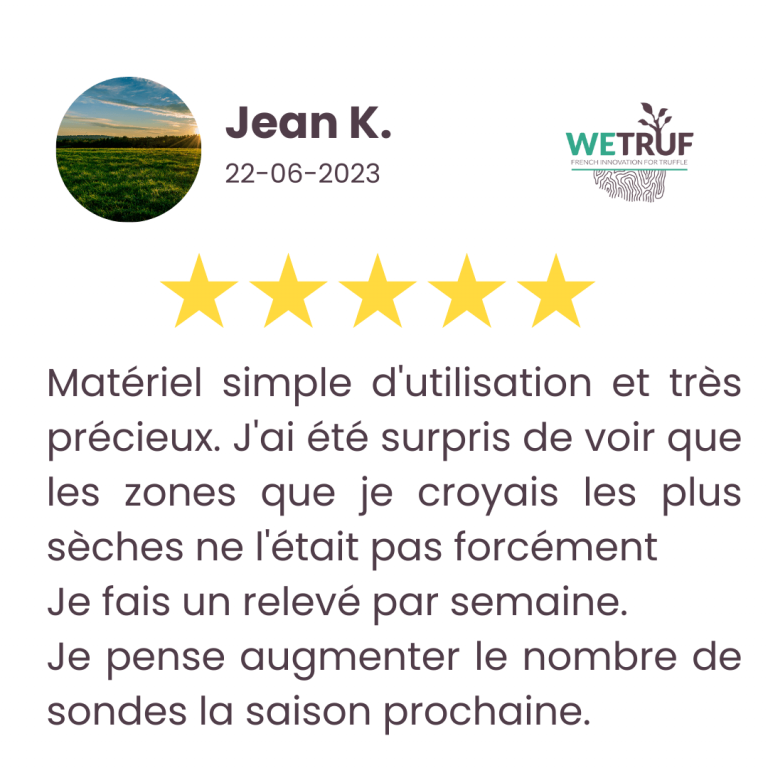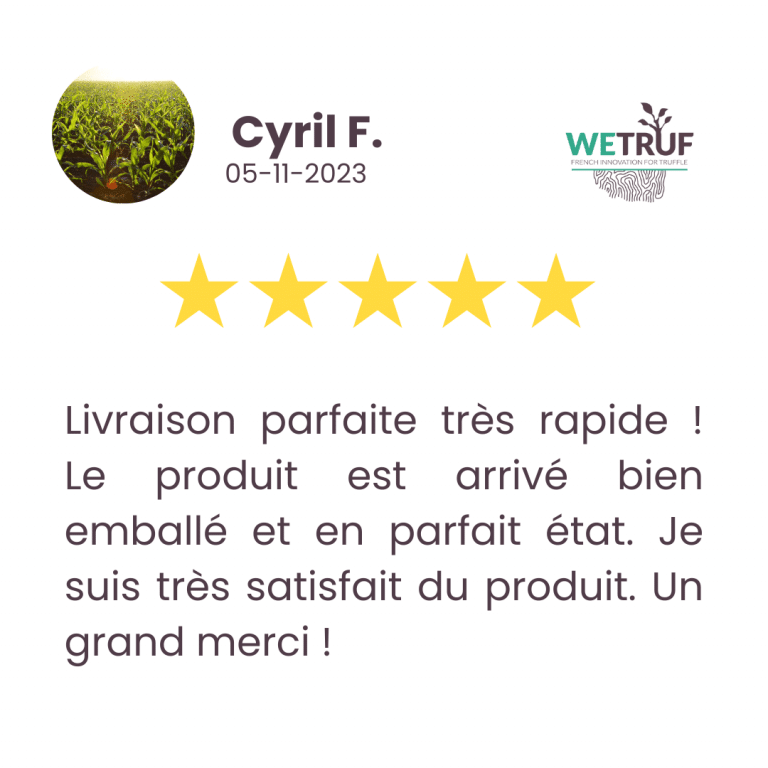Stay tuned!
Subscribe to the newsletter to stay informed about our new training courses, our new products and our latest tips for growing your truffle farm!
WETRUF® Plaster Probe
The WETRUF® Duo probe is dedicated to monitoring pF and soil temperature via pF Tracer® One+ and pF Tracer® Pro.

WETRUF® Plaster Probe
A reliable reading range for truffle farming.
The plaster probe is used to monitor soil water potential between pF 2.5 and 4.5.
In truffle-growing, it’s important to read a pF of at least 4, which corresponds to the wilting point.
Research and experiments carried out as part of the CULTURTRUF – INRAE project have validated this watering threshold for Tuber melanosporum.
Understand and interpret your plot data.
Temperature monitoring allows us to understand how variations in soil temperature impact truffle production and how they relate to variations in pF.
To find out more, read our article on soil temperature.
Perfect compatibility: the right probe for our pF Tracer® range
The Duo probe is specially assembled by us for use with pF Tracer® One + and pF Tracer® Pro.
This probe is fitted with a connector identical to that on the pF Tracer® boxes, enabling them to be linked together, and is also equipped with a protective sheath to protect it from any damage caused by animals or other hazards.
WETRUF® Plaster Probe
Step 1
Soil and probe preparation
Remove the first top layer of soil to a depth of about 5 cm.
Dig a hole about 15 cm deep.
Using a hoe, dig a trench in the extension of the hole, into which the probe cables will later be buried.
Meanwhile, immerse the plaster sensor in water.


Step 2
Contact between sensor and earth
Place the soil in a container, add a little water and water the bottom of the hole. Mix the soil with the water to form a paste. Surround the plaster sensor on one side and the temperature sensor on the other with the soil-water mixture, so that the mixture makes good contact with each sensor.
Step 3
Sensor installation
Place the sensors in the hole, with the cables facing downwards. Add the rest of the soil-water mixture around the sensors, packing lightly.
In the hole: place the temperature sensor at least 10 cm from the plaster sensor, ensuring that they do not touch.
In the trench: lay the rest of the cables, bringing the connector out of the ground, which can be fixed to a stake.


Step 4
Checking probe operation
Connect the Duo WETRUF® probe to the pF Tracer®. Check the pF value, which should be at field capacity, around 2.5.
WETRUF® Plaster Probe

The 2-point intermediate connector/adapter allows either :
It is possible to set up a whole network of sensors on the whole truffle field, the number of sensors to be installed depending mainly on the characteristics of the land.
WETRUF® Plaster Probe




The probe’s plaster sensor and temperature sensor are buried in the soil at the foot of the tree, in the truffle harvesting or “burnt” area, at a depth of around 15 cm. The sensors are intended to remain in the ground to monitor pF and temperature.
The connector at the end of the probe remains outside the soil and can, for example, be fixed to a stake for greater convenience.
A detailed protocol for installing the probe in the soil, supplied with the equipment and available on our website, must be scrupulously followed for optimum measurement and effective monitoring of pF and temperature.
The plaster and temperature probes do not require calibration; they will naturally equilibrate with the soil within a few days, and will be fully operational once the soil has been homogenized, after a heavy rainfall for example. If rain is not forecast, we recommend watering the area intensively after installation.
It is possible to set up a network of probes across an entire plantation, or to equip just a few trees in the plantation.
The number of probes to be installed will depend mainly on the characteristics of the terrain.
If the texture and/or physico-chemical composition of the soil is heterogeneous, we recommend fitting probes to each different sub-plot of land identified.
It may be advisable to install several probes at different soil depths in order to test the soil’s water retention capacity and useful reserves.
Once installed, the plaster probe has a lifespan of 2 to 5 years, depending on the nature of the soil. We recommend removing probes during winter to extend their service life.
There are some non-negligible factors that can influence the pF measurement.
For effective measurement, ensure that the gypsum sensor is in direct contact with the ground, if necessary by removing large stones from the vicinity of the probe, or even by coarse sieving.
Be careful, however, not to deviate from actual site conditions by exaggeratedly modifying the nature of the soil in the area where the probe is to be installed.
It is also advisable to eliminate vegetation in the probe installation area to avoid a “wicking” effect.
The probes can be removed from the soil in early winter and reinstalled the following spring after tillage.
The probes can also be removed for tillage and then reinstalled.
In the event of water shortage or drought, the sensor may come into poor contact with the soil, or even lose contact. In this case, if an aberrant pF value occurs, simply dig out the sensor, soak it in water, check the pF 2.5 value in water if necessary, then reinstall.
Subscribe to the newsletter to stay informed about our new training courses, our new products and our latest tips for growing your truffle farm!